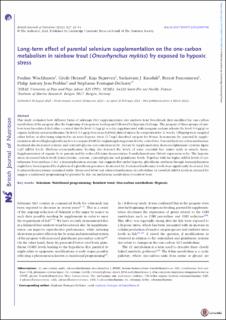Long-term effect of parental selenium supplementation on the one-carbon metabolism in rainbow trout (Oncorhynchus mykiss) fry exposed to hypoxic stress
Wischhusen, Pauline; Heraud, Cécile; Skjærven, Kaja Helvik; Kaushik, Sadasivam J.; Fauconneau, Benoit; Prabhu, P. Antony Jesu; Fontagné-Dicharry, Stéphanie
Peer reviewed, Journal article
Published version
Permanent lenke
https://hdl.handle.net/11250/3002024Utgivelsesdato
2022Metadata
Vis full innførselSamlinger
- Articles [3012]
- Publikasjoner fra CRIStin [3066]
Sammendrag
This study evaluated how different forms of selenium (Se) supplementation into rainbow trout broodstock diets modified the one-carbon metabolism of the progeny after the beginning of exogenous feeding and followed by hypoxia challenge. The progeny of three groups of rainbow trout broodstock fed either a control diet (Se level: 0·3 µg/g) or a diet supplemented with inorganic sodium selenite (Se level: 0·6 µg/g) or organic hydroxy-selenomethionine (Se level: 0·6 µg/g) was cross-fed with diets of similar Se composition for 11 weeks. Offspring were sampled either before or after being subjected to an acute hypoxic stress (1·7 mg/l dissolved oxygen) for 30 min. In normoxic fry, parental Se supplementation allowed higher glutathione levels compared with fry originating from parents fed the control diet. Parental hydroxy-selenomethionine treatment also increased cysteine and cysteinyl–glycine concentrations in fry. Dietary Se supplementation decreased glutamate–cysteine ligase (cgl) mRNA levels. Hydroxy-selenomethionine feeding also lowered the levels of some essential free amino acids in muscle tissue. Supplementation of organic Se to parents and fry reduced betaine-homocysteine S-methyltransferase (bhmt) expression in fry. The hypoxic stress decreased whole-body homocysteine, cysteine, cysteinyl-glycine and glutathione levels. Together with the higher mRNA levels of cystathionine beta-synthase (cbs), a transsulphuration enzyme, this suggests that under hypoxia, glutathione synthesis through transsulphuration might have been impaired by depletion of a glutathione precursor. In stressed fry, S-adenosylmethionine levels were significantly decreased, but S-adenosylhomocysteine remained stable. Decreased bhmt and adenosylmethionine decarboxylase 1a (amd1a) mRNA levels in stressed fry suggest a nutritional programming by parental Se also on methionine metabolism of rainbow trout.
